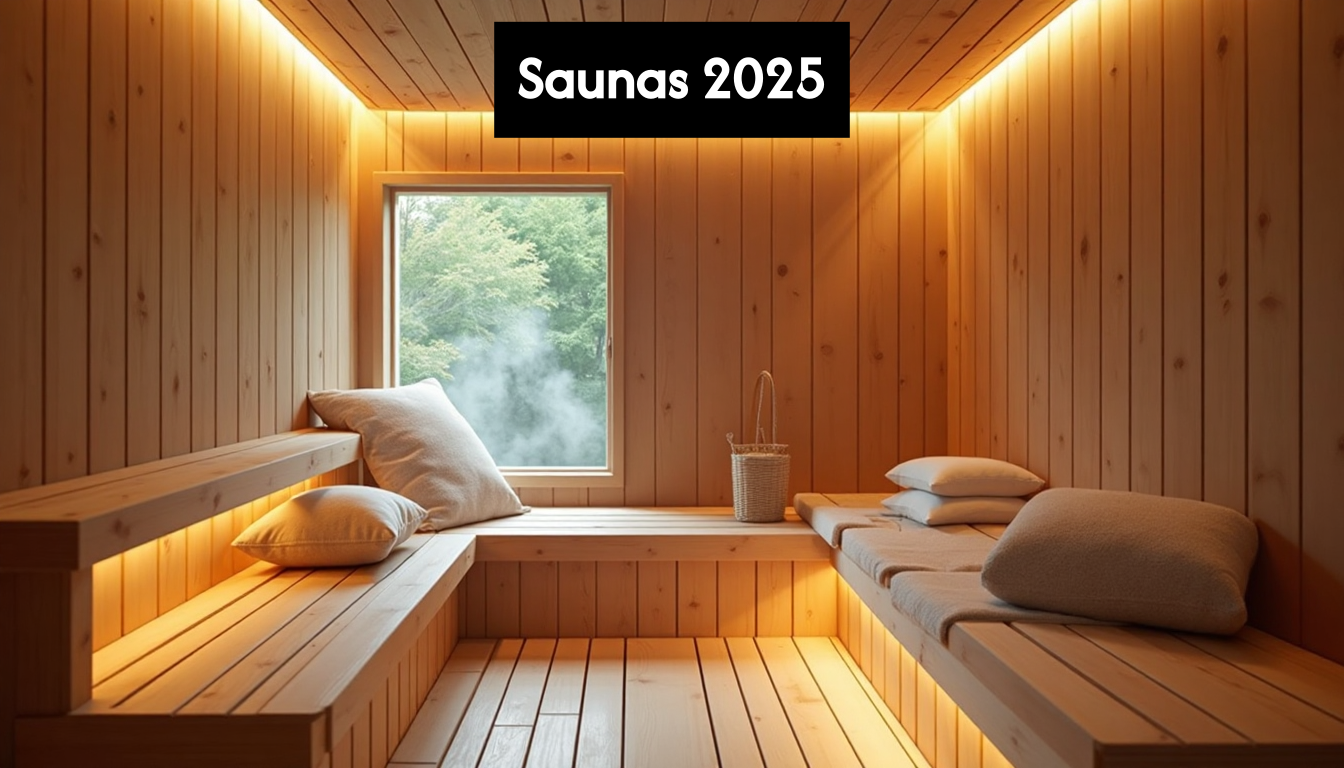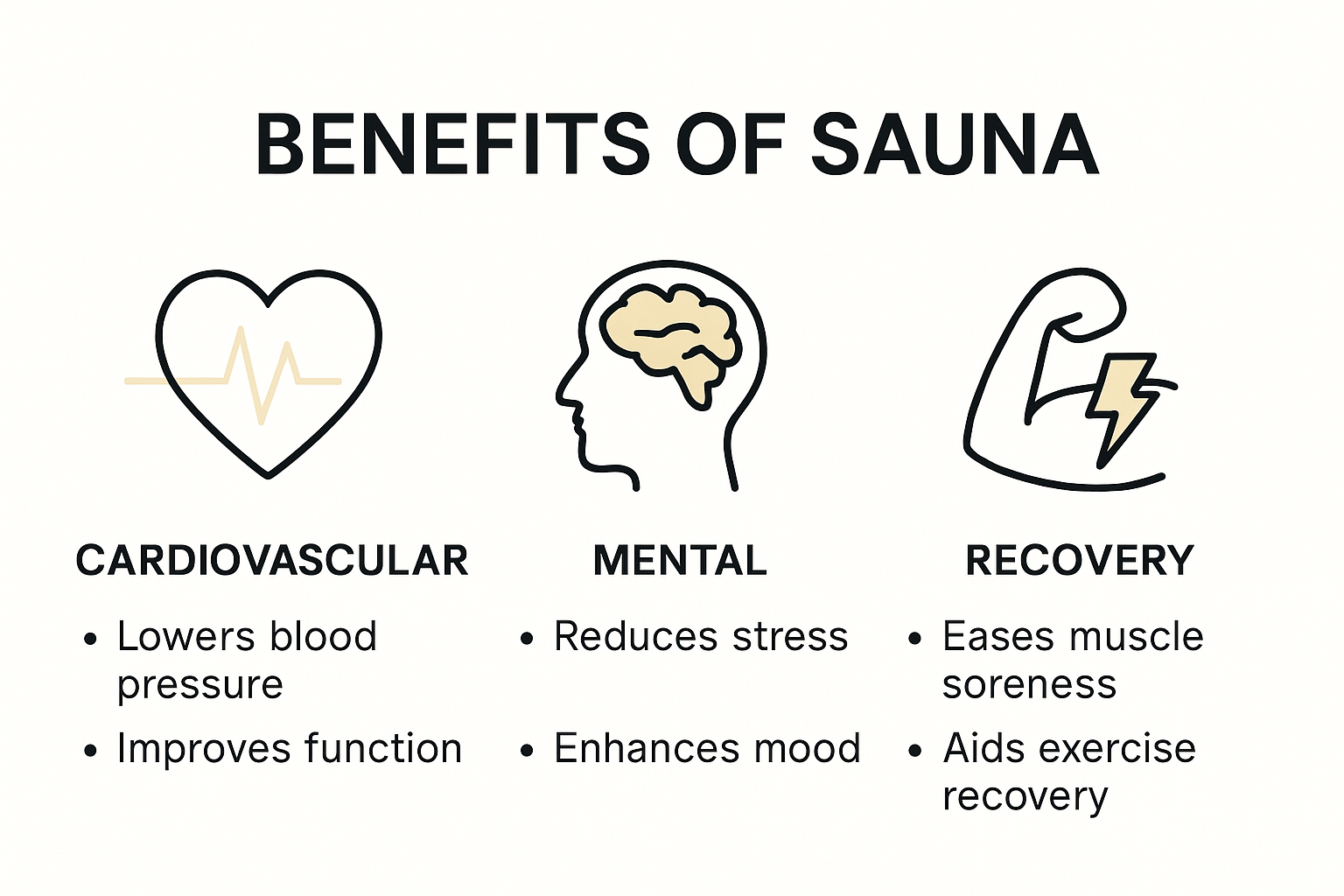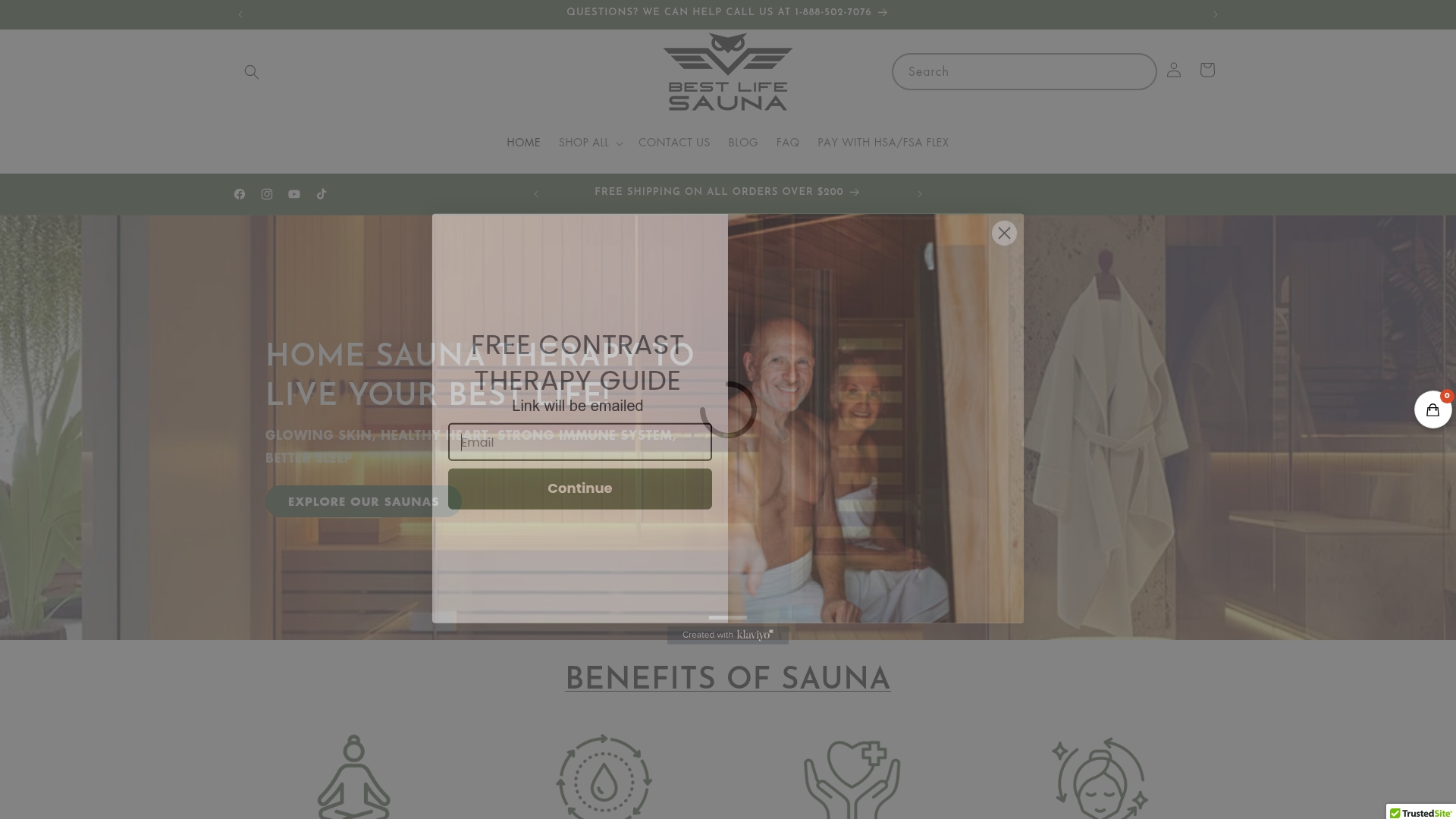
What to Know About Saunas in 2025: Health, Types & Home Tips

Saunas are grabbing attention for more than just relaxation these days. A study from Finland found that regular sauna use cuts cardiovascular risk by up to 63 percent. Surprising, right? Most people assume that saunas are only about unwinding after a long day. The real twist is that science shows using a sauna may do more for your heart and mind than your usual gym workout ever could.
Table of Contents
- Understanding Sauna Health Benefits
- Types Of Saunas And How They Work
- Safety Tips And Best Practices
- Choosing The Right Sauna For Your Home
Quick Summary
| Takeaway | Explanation |
|---|---|
| Saunas provide significant health benefits | Regular sauna use enhances cardiovascular health, mental wellness, and aids in performance recovery by improving blood circulation and reducing stress. |
| Understand the different types of saunas | Choose between traditional dry, wet, or infrared saunas based on personal comfort, health goals, and desired heat experience. |
| Follow safety protocols during sauna use | Start with shorter sessions, stay hydrated, and be aware of personal health conditions to prevent discomfort or risks while using the sauna. |
| Consider space and budget for home saunas | Assess your available space and budget, as different sauna types and configurations have various installation needs and costs. |
| Consult professionals for personalized sauna choices | Engage with wellness and home improvement experts to ensure your sauna selection aligns with your health objectives and home dynamics. |
Understanding Sauna Health Benefits
Saunas represent more than just a relaxation experience. They are powerful wellness tools with significant potential health benefits backed by scientific research. Modern health enthusiasts are increasingly recognizing saunas as critical components of holistic wellness strategies.
Cardiovascular and Physiological Advantages
Regular sauna use offers remarkable cardiovascular benefits. Research from the University of Eastern Finland demonstrates that consistent sauna sessions can positively impact heart health and overall physiological functioning. The heat exposure triggers several beneficial physiological responses, including enhanced blood circulation and improved cardiovascular efficiency.
The body’s response to intense heat mimics moderate cardiovascular exercise. During a sauna session, heart rate increases, blood vessels dilate, and metabolic processes accelerate. These changes contribute to improved cardiovascular performance and potential long-term health benefits. Individuals experiencing high blood pressure or cardiovascular concerns might find sauna sessions particularly advantageous.

Mental Health and Stress Reduction
Beyond physical benefits, saunas provide significant mental health advantages. A population-based study in northern Sweden revealed compelling insights into the psychological impact of regular sauna use. Participants reported higher energy levels, increased happiness, and improved overall mental well-being.
The heat-induced relaxation process stimulates the release of endorphins and reduces cortisol levels. This hormonal response helps mitigate stress, promotes better sleep quality, and supports emotional regulation. For individuals managing chronic stress or seeking natural relaxation techniques, saunas offer a holistic approach to mental wellness.
Performance Recovery and Immune Support
Athletes and fitness enthusiasts increasingly incorporate saunas into their recovery protocols. The intense heat exposure helps muscles recover faster by increasing blood flow and reducing inflammation. Sauna sessions can accelerate muscle repair processes and potentially reduce post-exercise soreness.
Additionally, emerging research suggests potential immune system benefits. The controlled heat stress may stimulate the production of heat shock proteins and enhance immune cell functionality. While more research is needed, initial studies indicate that regular sauna use could contribute to improved immune resilience.
Before integrating saunas into your wellness routine, consult healthcare professionals. Individual health conditions, hydration levels, and personal tolerance vary. Start with shorter sessions and gradually increase duration, always listening to your body’s responses.
The International Journal of Circumpolar Health continues to highlight the multifaceted benefits of sauna use, reinforcing its potential as a comprehensive wellness strategy. As research evolves, saunas are transforming from simple relaxation spaces to critical tools in holistic health management.

Types of Saunas and How They Work
Understanding the various sauna types is crucial for selecting the right wellness experience. Each sauna technology offers unique characteristics that cater to different health and relaxation preferences.
Traditional Dry and Wet Saunas
Traditional saunas represent the classic heat therapy experience originating from Nordic cultures. Field Magazine identifies two primary subcategories: dry saunas and wet saunas. Dry saunas operate at high temperatures between 170-200°F with very low humidity, creating an intense heat environment that prompts profound sweating and physiological responses.
Wet saunas, alternatively known as steam saunas, introduce moisture through water being poured over heated rocks. This process creates a humid environment with temperatures typically ranging from 110-120°F. The added humidity intensifies the heat sensation and can feel more comfortable for individuals who struggle with extremely dry heat environments.
Infrared Sauna Technology
Infrared saunas represent a modern approach to heat therapy, operating differently from traditional models. Innovative Wellness Research suggests these saunas use electromagnetic waves to directly warm the body, functioning at lower temperatures between 120-140°F. This unique heating method penetrates body tissues more directly, potentially offering more targeted therapeutic benefits.
The key distinction lies in heat transmission. While traditional saunas heat the surrounding air, infrared saunas warm the body directly. This approach allows for deeper tissue penetration and potentially more efficient metabolic responses. Users often report feeling more comfortable and experiencing less overall environmental heat stress compared to traditional sauna experiences.
Hybrid and Specialized Sauna Configurations
Emerging sauna technologies are blending traditional and modern approaches. Gardens Genie highlights hybrid InfraSaunas as a cutting-edge option, enabling users to switch between heating technologies. These versatile units combine infrared and traditional heating methods, providing unprecedented flexibility in personal wellness routines.
When selecting a sauna, consumers in 2025 should consider five critical factors: heating method (electric, wood-fired, or infrared), type (traditional or infrared), size, construction material, and additional features. Wood-fired saunas offer a traditional experience with natural heat generation, while electric models provide precise temperature control and easier installation.
Choosing the right sauna depends on individual health goals, space constraints, and personal comfort preferences. Some individuals might prioritize intense heat experiences, while others seek gentler, more targeted therapeutic approaches. Consulting with wellness professionals can help determine the most suitable sauna type for specific health and relaxation objectives.
Safety Tips and Best Practices
Sauna use requires careful attention to safety protocols to ensure a positive and healthy experience. Understanding potential risks and implementing appropriate precautions is essential for maximizing the wellness benefits while minimizing potential health complications.
Session Duration and Personal Monitoring
Medical News Today recommends that first-time sauna users start with conservative session lengths. Beginners should initiate their sauna practice with 5-10 minute sessions, gradually increasing duration as their body adapts to heat exposure. Experienced users can extend sessions up to a maximum of 20 minutes, always maintaining awareness of personal comfort and physiological responses.
Careful self-monitoring is crucial during sauna use. Watch for signs of heat exhaustion such as dizziness, rapid heartbeat, nausea, or excessive sweating. Individuals should exit the sauna immediately if experiencing any discomfort. Hydration plays a critical role in safe sauna practice. Drink water before, during, and after sessions to replace fluids lost through perspiration.
Health Considerations and Precautionary Measures
Home In-Depth Health Guide emphasizes specific precautions for vulnerable populations. Pregnant women, children, and individuals with pre-existing health conditions should consult healthcare professionals before sauna use. Certain medical conditions like heart disease, low blood pressure, or respiratory issues may require special consideration or complete avoidance of sauna sessions.
Alcohol consumption before or during sauna use significantly increases health risks. The combination of heat and alcohol can lead to dehydration, impaired judgment, and potential cardiovascular complications. Always approach sauna sessions with a clear mind and well-hydrated body. Individuals taking medications that affect temperature regulation or heart rate should seek medical guidance before incorporating saunas into their wellness routine.
Equipment Safety and Environmental Considerations
Home Maintenance Guidelines recommend annual safety inspections for home sauna equipment. Check electrical connections, heating elements, and safety features monthly to ensure optimal performance and prevent potential hazards. Start with lower temperature settings and carefully monitor thermometer readings, especially when using a new sauna or unfamiliar equipment.
Environmental factors also impact sauna safety. Ensure proper ventilation and maintain a clean sauna environment to prevent moisture buildup and potential bacterial growth. Use clean towels, avoid wearing excessive clothing, and maintain personal hygiene to create a safe and comfortable sauna experience.
Special considerations apply to different sauna types. Infrared saunas operate at lower temperatures but still require careful use. Traditional wood-fired or electric saunas demand additional attention to heat management and equipment maintenance. Regardless of sauna type, prioritize personal safety, listen to your body, and approach heat therapy as a mindful wellness practice.
Remember that individual tolerance varies. What works for one person may not be suitable for another. Pay attention to your body’s signals, stay hydrated, and never hesitate to exit the sauna if you feel uncomfortable. Sauna use should be a relaxing and beneficial experience that supports your overall health and wellness goals.
Choosing the Right Sauna for Your Home
Selecting the perfect home sauna requires careful consideration of multiple factors. Your choice will impact not just your wellness routine but also your home’s aesthetic and functional dynamics.
Sauna Types and Configuration Options
The Spruce Home Guide identifies four primary home sauna configurations. Infrared saunas use ceramic or carbon heaters providing dry heat, while steam saunas introduce moisture through specialized heating elements. Portable saunas offer maximum flexibility for those with limited space, and traditional wooden saunas provide a classic heat therapy experience.
Infrared models have gained significant popularity due to their energy efficiency and easier installation. These units typically operate at lower temperatures and provide direct body heating, making them ideal for individuals seeking targeted wellness benefits. Traditional saunas, conversely, offer more intense heat experiences and the option to create steam by pouring water over heated rocks.
Space and Capacity Considerations
Home In-Depth Wellness emphasizes the importance of assessing available space and desired capacity. Home sauna models range from compact 2-person units perfect for apartments to expansive 5-person configurations suitable for larger family homes. Consider not just current space requirements but potential future needs.
Modern saunas come equipped with sophisticated features beyond basic heating. High-end models now include mobile app controls, Bluetooth audio systems, and customizable LED lighting. These technological integrations transform saunas from simple wellness spaces to immersive relaxation environments. When evaluating options, balance aesthetic preferences with practical functionality.
Budget and Installation Factors
Budget plays a crucial role in sauna selection. Entry-level infrared models start around $1,500, while premium traditional wooden saunas can exceed $10,000. Home Wellness Experts recommend considering long-term operational costs alongside initial investment. Factors like electricity consumption, maintenance requirements, and potential home value enhancement should influence your decision.
Installation complexity varies significantly between sauna types. Infrared units often require minimal setup and can be plugged into standard electrical outlets. Traditional saunas might necessitate professional electrical work, proper ventilation planning, and potentially structural modifications. Some homeowners opt for outdoor sauna installations to minimize interior renovation requirements.
Prioritize professional consultation before final purchase. Certified wellness and home improvement professionals can provide personalized recommendations based on your specific health goals, home layout, and budget constraints. Remember that a sauna represents an investment in personal wellness, so careful selection ensures years of therapeutic benefits and relaxation.
Frequently Asked Questions
What are the health benefits of using a sauna?
Regular sauna use can enhance cardiovascular health, reduce stress, improve mental wellness, aid in performance recovery, and potentially boost immune support.
What types of saunas are available in 2025?
In 2025, you can choose from traditional dry saunas, wet saunas (steam saunas), infrared saunas, and hybrid models that combine different heating technologies.
How long should you stay in a sauna for health benefits?
Beginners should start with 5-10 minute sessions, gradually increasing to a maximum of 20 minutes based on personal comfort and tolerance levels.
What factors should I consider when choosing a sauna for my home?
Consider factors such as the type of sauna (infrared or traditional), space availability, budget, installation requirements, and desired features like technology integrations.
Ready to Transform Your Health and Home With Sauna Wellness?
You’ve just learned how saunas in 2025 offer more than simple relaxation. Maybe you’re concerned about picking the right sauna for your space or you want solutions that truly support cardiovascular health, stress relief, and faster workout recovery. The pain of uncertainty or fear of making the wrong investment can slow you down on your wellness journey. What if you could solve these problems with ease, confidence, and the latest in sauna technology?

See how the experts at Best Life Sauna make choosing and enjoying the perfect sauna simple. Our collection covers everything discussed in the guide—from premium infrared saunas for deep muscle recovery to traditional and outdoor models that let you bring classic relaxation home. Explore our selection and take advantage of free shipping on orders over $200. Now is the moment to build healthy living into your daily routine. Discover ultimate wellness solutions and feel the difference a tailored sauna experience can make.

